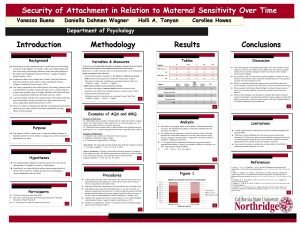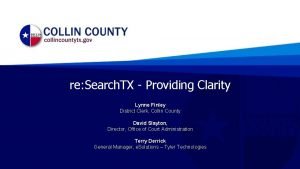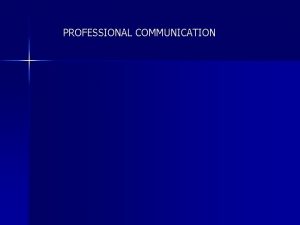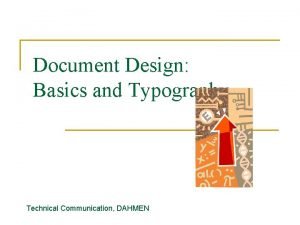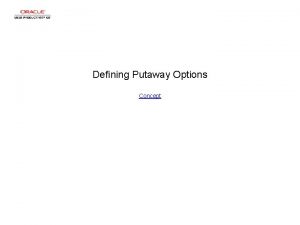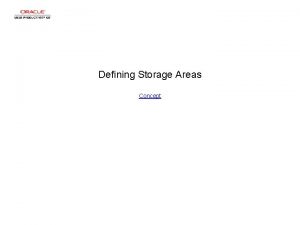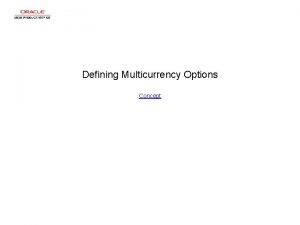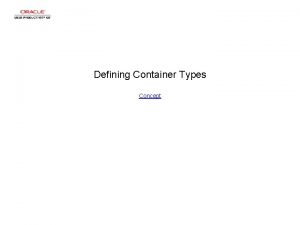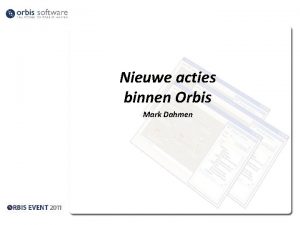Professional Communication Lynne Dahmen Defining Professional Com all















- Slides: 15

Professional Communication Lynne Dahmen

Defining Professional Com «…all forms of speaking listening, relating, writing and responding in the workplace, both human and electronically mediated » Goodall and Goodall, 3

New Applications of Communication Models Message Receiver Sender Channel

Impinging Components l Noise Environment Physical Semantic Hierarchical l Communication history l l l l l Physical Organizational Time Cultural Feedback

Functional Approach to Com l Organize tasks/people l Create identities l Create meaning/interpretation

Organizational Identity l Persona l Credibility l Savvy

Researching a communication Environment l Pay attention to external environments l Note the organization of people, furniture, style of dress, language spoken, etc l Listen to how the employees talk and what they discuss l Ask questions!

Consciousness- « The mental state that brings us together with others involved in a communication context. Being conscious means that we are at once ‘an observer, a perceiver, a knower, a thinker and a potential actor’. » --Goodall and Goodall, 15

The CCCD Process l Choose l Create l Coordinate l Deliver

Steps towards Choosing a Goal l Audience analysis l Outcomes l Criteria for Success

Steps for Creating a Message l Develop a purpose/thesis l Organize your points l Develop your support l Craft effective strategies for delivering message—intros, transitions, conclusions

Coordinate with Others l How does your message fit into the organization? l Communicate with others as needed l What are some possible boundaries. l Adapt your message to the environment, situation, organization etc.

Adapting Coordination l Information l Communication l Respect l Adaptation

Types of Delivery l Reports l Presentations l Interpersonal Communication

Discovering Communication in the Moroccan Workplace Talk to a relative, parent or other individual you know who currently works in the Moroccan workplace. Ask him/her to rate the importance of interpersonal, organizational, team, speaking, written communication and presentational skills in his/her workplace. Explain to him/her the course you are taking and seek feedback on how these skills might benefit you as you try to integrate into the marketplace in the future. Also ask him/her about how things have changed (if they have) in the last 10 or 15 years. In a brief memo, discuss your findings, making sure to identify the business or organization in which the individual works, his/her role in the organization, and perhaps how long he/she has worked for this organization or business.
 Bài thơ mẹ đi làm từ sáng sớm
Bài thơ mẹ đi làm từ sáng sớm Cơm
Cơm Mara dahmen
Mara dahmen Daniella dahmén
Daniella dahmén Durk berks
Durk berks Non defining relative clause examples
Non defining relative clause examples Relative clauses defining and non defining
Relative clauses defining and non defining Relative pronouns defining and non-defining
Relative pronouns defining and non-defining Defining relative clause meaning in telugu
Defining relative clause meaning in telugu Non defining relative clauses
Non defining relative clauses Defining or non defining relative clauses
Defining or non defining relative clauses Lynne jones waylon jennings wife
Lynne jones waylon jennings wife Lynne hillenbrand
Lynne hillenbrand Marybeth tinning tami lynne tinning
Marybeth tinning tami lynne tinning Lynne finley district clerk
Lynne finley district clerk Lynne korte
Lynne korte



